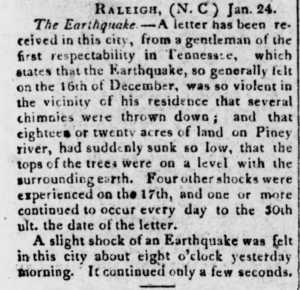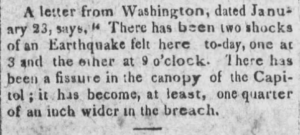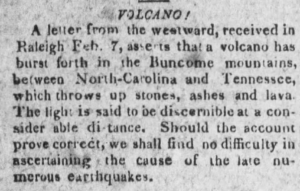From December 1811 through March 1812, three powerful earthquakes and more than two thousand aftershocks rocked New Madrid, Missouri, and the surrounding area. The quakes were felt as far south as New Orleans and as far north as Canada. The United States Geological Survey estimates the power of the earthquakes ranged between magnitude 7 and 8, making them the strongest events recorded in North America east of the Rocky Mountains. Deep fissures opened, church bells rang as far away as Boston, and chimneys fell in Ohio. The Mississippi River reportedly ran backward, and geysers erupted from the earth. The loss of life was minimal due to the area’s sparse population. We’ve combed our archives to bring you some of the news reports of this disaster, originally published more than 200 years ago.
The first quake struck on December 16, 1811. The Alexandria Gazette reported that 20 acres of land suddenly sunk during intense shaking, and the “tops of the trees were on a level with the surrounding earth.”
The sinking trees were the result of an earthquake-induced phenomenon called liquefaction. The strong shaking caused the sediment to lose strength, and the solid material suddenly behaved like a liquid. The quake dramatically altered the landscape near New Madrid. Sections of land lifted so high that the Mississippi River temporarily flowed backward. Fissures in the ground opened, venting sediments, mud, sticks, and water high into the air.
The second large quake happened on January 23, 1812, with an estimated strength of 7.5. People living in Annapolis, Maryland, reported that the steeple on the Maryland State House swayed back and forth for about 10 minutes. President James Madison felt shaking at the White House, and a crack developed in the Capitol building.
The third large quake occurred on February 7, 1812, and it was accompanied by violent wind and lightning. With everyone’s nerves on edge, rumors spread that a volcano had erupted between North Carolina and Tennessee and that a lava flow had dammed the French Broad River. The stories proved false, and gradually, the tremors stopped.
Seismologists predict that in the next 50 years, there’s a 10 percent chance of a similar magnitude earthquake in the New Madrid Seismic Zone to those of 1811-1812 and a 25 to 40 percent chance of a magnitude 6 or greater over that same time. A major New Madrid earthquake would wreak havoc in parts of Alabama, Arkansas, Illinois, Indiana, Kentucky, Mississippi, Missouri, and Tennessee. Roads would likely be impassable, bridges and levees would collapse, and the Mississippi River would become unnavigable.
Do you have ancestors who experienced the New Madrid earthquakes? To learn more about the New Madrid Seismic Zone and to read more historical accounts of the earthquakes, search Newspapers.com™ today!






I seem to remember a that a lake disappeared during one of the quakes. Is that true?
Reelfoot Lake was created as a result of the earthquake trapping water from the Mississippi River flowing backward.
Yes. Look up Reelfoot Lake.
It’s 2023 and we STILL don’t have Silverton Oregon newspaper. Good God! :/ We have the Statesman Journal on here but no Silverton Tribune!
We are unable to digitize the Silverton Tribune due to copyright restrictions. We hope to find a way to work with this publisher and digitize this paper in the future.
How does one get a newspaper digitized with y’all? My mom was the editor and publisher of a small town newspaper in Texas and I feel it would be great to have it digitized. She’s 94 now and I think it would mean a lot to her. She and my dad are Navy Korean War veterans and were both involved in the North Lake Travis Log newspaper.
Tracey, I don;t know about Newspapers,com, but the Timpson Public Library in Timoson, Texas got a grant from the Tocker Foundation to put our local newspapers on Portal to Texas History at UNT.
Tracey, small-town papers are so great! From the Newspapers.com home page, just scroll to the bottom and select “Content Providers.” Someone from our team will contact you. Thanks.
I love to fish and canoe in Reelfoot Lake, the lake that the quakes formed in northwestern Tennessee when the ground sank.
I remember a story about an elderly man who had an outhouse in Missouri until the quake moved the Mississippi and relocated the structure to Tennessee. Now they are fracking oil in the area near New Madrid….wonder how long until Mother Nature sends out her anger again. We have already had a 2.9 in the northern parts of Missouri and we are not used to being shaken and stirred!
The Texas Railroad Commision tells us that fracking and saltwater disposal has nothing to do with earthquakes. They have failed to explain why the 2012 earthquakes in our area stopped after fracking and saltwater waste disposal in our area were greatly reduced.
Warsaw Mo was on or near the New Madrid fault. Our now pastors wife was the local trainer on how to survive an earthquake and what to do in case of one.
My 4th gr grandfather and his wife and at least 5 of his eventual 10 children were in Mercer Co KY or west enroute at this time..by 1817 I found them in central MO—how did they get there? Only flatboats to cross the MS River ?? Can’t help but wonder what happened to them during the quake. I live in Shelby Co TN, which is on the MS River…guess I may be able to take it all with me !!
The first riverboat came down the Ohio River and proceeded into the Mississippi headed for New Orleans in 1811 and was caught in the wild waves and reversed river flow by the earthquake. So after that there were riverboats that began to operate on the Ohio and Mississippi. One went up the Missouri in 1819, but it was so dangerous due to snags and logs that no more went up the river until 1831, after the invention and use of a snag pulling boat.
Thank you for that information. I know the area was sparsely occupied but this family of mine can’t be found between 1813 in KY and 1817 in MO so I presume they must have been enroute and fairly safe but where is another unanswered question.
John James Audubon, the naturalist and painter, was riding his horse in KY when the quake struck. He reported the land around him rose and fell like the waves on a lake.
I find the whole history of this earthquake fascinating and often wonder how things would turn out very differently in the densely populated areas today. If you travel along the points impacted by the quake, there’s lots to see. Reelfoot Lake is beautiful and abounds with wildlife. New Madrid, MO is a cute little town and there’s a lovely little museum which has lots of information on the quake. Of course, you can also pick up your obligatory “It’s Our Fault” t-shirt and stand on the fault line outside. I have to say it’s a bit eerie standing there. And lastly, for anyone interested in the subject, there’s also a wonderful book called, “When the Mississippi Ran Backwards: Empire, Intrigue, Murder, and the New Madrid Earthquakes of 1811-12.”
My 3x great-grandfather, Joseph Johnston and wife, Rebecca Bryan Johnston moved to the Femme Osage, Missouri area in 1806 to be near the Boone/Bryan family members. They would have lived through these earthquakes in that area, but as family historian I’ve not run across any family stories of what that was like for them. I’m sure it was traumatic, as it would have been for all living in that New Madrid fault area. So I glean from the reports of others and of the day’s newspapers on what it was like. Were quakes of that strength to happen today in the same area(s), the result would be horrific.
Thank you for that information. I know the area was sparsely occupied but this family of mine can’t be found between 1813 in KY and 1817 in MO so I presume they must have been enroute and fairly safe but where is another unanswered question.
I’m a genealogist. If you have the start point, look for a copy of the Dollarhide collection of transportation routes. Its starts with the first footpaths of explorers. Depending on the years people traveled by footpaths, water and wagon paths.
Thank you for that information! I lived in a house in St. Joseph, Missouri, for several years. It had a large crack from one of the earthquakes.
Where can the Dollarhide collection be found?
I went to school in Fulton, MO on 1968 at William Woods College now a University. One morning I got up early on Saturday to walk across campus. As I walked down the hall, the metal doors started banging in the frames. I didn’t feel any movement as I was walking. Found out later we had a .6 quake a few miles away. Later in the ‘90s, working in Commercial Insurance, we expected the next big quake to be in Memphis. Still waiting.
Mary: Remember that Saturday morning as if it were yesterday. Was a sophomore at The U of Mo in Columbia as was awakened by the rumbling of my windows in my room. Knew it was different than anything I ever felt and found out later it was an earthquake. Feel fortunate now it was not like the New Madrid quake. Thanks for the memories.
I remember that Saturday in 1968 even though I was 11 years old. On Saturday mornings my 2 cousins and I would be taken by their mother or mine from Marthasville, MO to Washington, MO for piano lessons. The lessons were given in a big church and two girls would play and explore while the third had her lesson. The two of us felt the shaking and heard rumbling noises, got frightened and raced into the piano lesson room and the safety of our piano teacher! Later I was told that some windows were broken but we were safe, just scared little girls.
I also remember that quake — and I was in Maynard in northeast Iowa! The ceiling lights swayed back and forth for several minutes.
Is anyone aware of newspaper reports citing Tecumseh’s prediction of the quake as a signal for his tribal allies to gather for his last big battle?
I just ordered the dollarhide collection on Amazon.
I just ordered the dollarhide collection on Amazon.